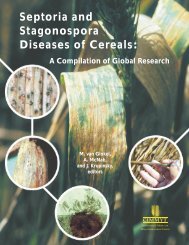Section 3 (Crop Management)
Section 3 (Crop Management)
Section 3 (Crop Management)
Create successful ePaper yourself
Turn your PDF publications into a flip-book with our unique Google optimized e-Paper software.
Harris et al.<br />
In Pakistan, priming gave statistically significant grain yield increases in 11 (79%) of the trials. In the<br />
remaining 3 (21%) trials, priming was associated with a large, but non-significant, yield increase and two<br />
other instances where small positive yield differences were not significant. Priming was either better than<br />
not priming or was the same: it was never worse. This is a pattern encountered in other crops (see, for<br />
instance, Musa et al., 2001 for chickpea and Harris et al., 2001b for wheat) and, since priming is very low<br />
cost, it should be very attractive for farmers to prime their seed as a form of insurance.<br />
In the participatory, on-farm, trials all of the paired plot comparisons gave positive results: priming<br />
increased yield in all 32 trials (Figs. 1 and 2). In these FAMPAR trials series, the average response is due<br />
to priming whereas the result of individual trials may be affected by other, unknown, factors. If farmers<br />
only viewed their own plots this might be a problem from the point of view of dissemination and<br />
promotion, but our approach emphasises group evaluation of trials so that farmers can achieve a<br />
consensus view of the technology. This is important and is a factor in the rapid and sustained uptake of<br />
seed priming after exposure during participatory exercises such as those described here.<br />
Benefits due to priming extend beyond immediate yield increases in some circumstances. Harris et al.<br />
(2001a) listed farming-system-related effects of priming that were identified by farmers in India. Musa et<br />
al. (2001) concluded that seed priming in Bangladesh was the path-breaking technology that allowed<br />
chickpea to be grown profitably as a second crop after rice as an alternative to leaving the land fallow.<br />
There is a great deal of evidence that seed priming is an attractive ‘key’ technology – low cost and low<br />
risk – that is easily adopted by farmers.<br />
Acknowledgements<br />
The authors gratefully acknowledge the contributions made by support staff and farmers in Pakistan.<br />
This paper is an output from projects R7438 and R7189 funded by the UK Department for International<br />
Development through the Plant Sciences Research Programme. The views expressed are not necessarily<br />
those of DFID.<br />
Literature Cited<br />
Harris, D., Joshi, A., Khan, P.A., Gothkar, P. and Sodhi, P.S. 1999. On-farm seed priming in semi-arid<br />
agriculture: development and evaluation in maize, rice and chickpea in India using participatory<br />
methods. Experimental Agriculture 35: 15-29.<br />
Harris, D., Tripathi, R.S. and Joshi, A. 2000. ‘On-farm’ seed priming to improve crop establishment and<br />
yield in direct-seeded rice. Paper presented at the International Workshop on Dry-Seeded Rice<br />
Technology, held 25-28 January, Bangkok, IRRI.<br />
Harris, D., Pathan, A. K., Gothkar, P., Joshi, A., Chivasa, W. and Nyamudeza, P. 2001a. On-farm seed<br />
priming: using participatory methods to revive and refine a key technology. Agricultural Systems 69<br />
(1-2): 151-164<br />
Harris, D., Raghuwanshi, B.S., Gangwar, J.S., Singh, S.C., Joshi, K.D., Rashid, A. and Hollington, P.A.<br />
2001b. Participatory evaluation by farmers of ‘on-farm’ seed priming in wheat in India, Nepal and<br />
Pakistan. Experimental Agriculture 37 (3): 403-415.<br />
Harris, D., Rashid, A., Hollington, P.A., Jasi, L. and Riches, C. (2002). Prospects of improving maize<br />
yields with ‘on-farm’ seed priming. Pp 180-185 in: N.P. Rajbhandari, J.K. Ransom, K. Adikhari and<br />
A.F.E. Palmer (eds) ‘Sustainable Maize Production Systems for Nepal’: Proceedings of a Maize<br />
Symposium held, December 3-5, 2001, Kathmandu, Nepal. Kathmandu: NARC and CIMMYT.<br />
Musa, A. M., Harris, D., Johansen, C. and Kumar J. 2001. Short duration chickpea to replace<br />
fallow after aman rice: the role of on-farm seed priming in the High Barind Tract of<br />
Bangladesh. Experimental Agriculture 37 (4):<br />
- 319 -









